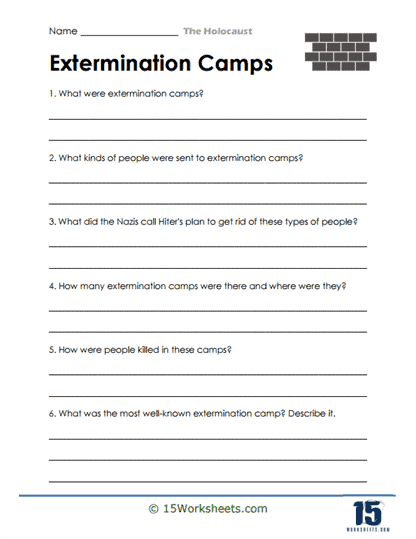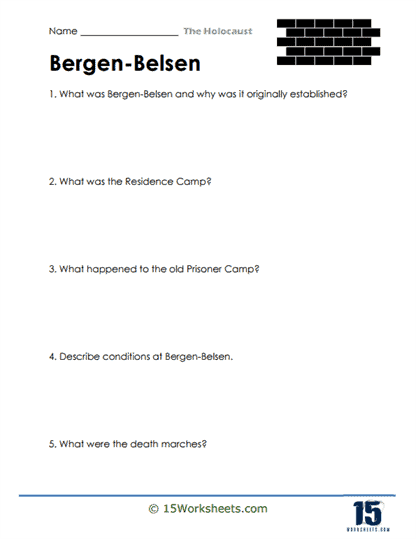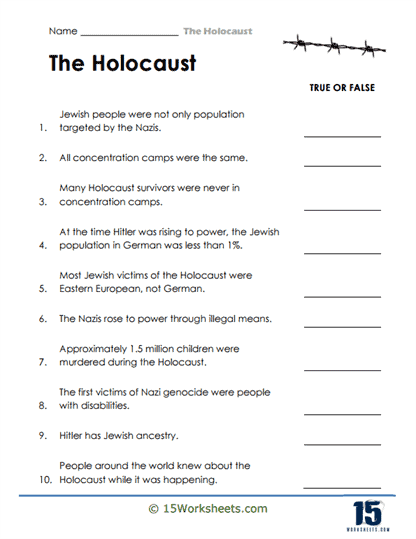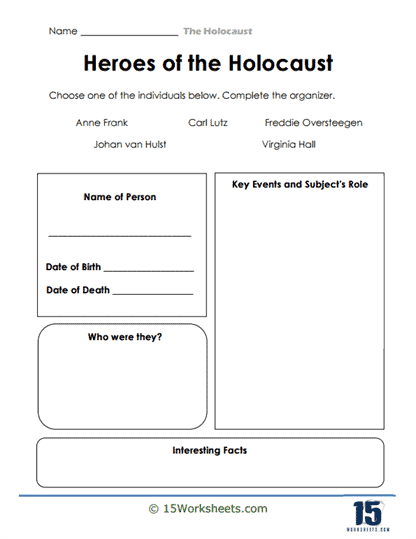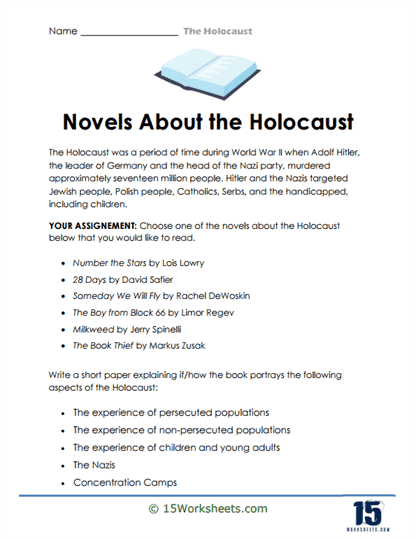Holocaust Worksheets
About These 15 Worksheets
These worksheets cover various aspects of the Holocaust, from the rise of the Nazi party and their ideologies to the experiences of survivors and the aftermath of the genocide. Through carefully curated content and exercises, these worksheets aim to educate students in a sensitive and informed manner.
The Holocaust, which occurred during World War II, is one of the most horrific events in human history. Between 1941 and 1945, six million Jews, along with millions of Romani people, Poles, Soviets, disabled individuals, political prisoners, and others, were systematically exterminated by the Nazi regime. Given the magnitude and gravity of this genocide, it’s imperative to educate future generations about it, ensuring that such atrocities are never repeated.
Types of Exercises On The Worksheets
Timelines and Maps – Students may be asked to chronologically arrange major events leading up to and during the Holocaust, offering a structured overview of its progression. Using maps, students can pinpoint key locations, such as concentration and extermination camps, ghettos, or significant battle sites.
Basic Questions – These gauge foundational knowledge about the Holocaust, its causes, the involved parties, and its outcomes. Encourage students to delve deeper into specific topics, such as life in the ghettos, the role of collaborators, or the experiences of particular victim groups.
Primary Source Analysis – Students might analyze photographs, diary entries, letters, or testimonies from the period, reflecting on the emotions, experiences, and realities they reveal. Focusing on prominent figures, such as Anne Frank, Oskar Schindler, or Adolf Eichmann, students can explore individual experiences and roles during the Holocaust.
Discussion and Reflection Activities – These might ask students to ponder the societal conditions that allowed the Holocaust, the psychology of bystanders, or the moral dilemmas faced by individuals. Given the wealth of literature arising from or reflecting on the Holocaust, students can be asked to read and analyze relevant works, discussing themes, character experiences, or the significance of memory.
The Value of These Worksheets For Students
The Holocaust stands as a stark testament to the depths of cruelty and inhumanity that can arise under particular conditions. By understanding its scope, students gain a sobering perspective on human potential for evil. Educating about the Holocaust highlights the dangers of unchecked prejudice, discrimination, and xenophobia. It underscores the importance of embracing diversity and promoting understanding among different communities.
The Holocaust was a complex event with multifaceted causes. Analyzing its origins and progression encourages students to think critically about propaganda, societal pressures, and the roles of individuals and institutions. Confronting the ethical dilemmas posed by the Holocaust – from the choices of individuals under duress to the responsibilities of nations and institutions – can help students forge strong moral compasses.
Genocides and mass atrocities didn’t end with the Holocaust. By studying it, students are better equipped to understand and respond to similar events in modern times, such as the genocides in Cambodia, Rwanda, or Darfur. As Holocaust survivors age and pass away, the mantle of memory falls to younger generations. Educated individuals can work to prevent Holocaust denial and revisionism, ensuring that its lessons are never forgotten.
The gravity of the Holocaust mandates careful, respectful, and informed education. While the lessons drawn from it are undoubtedly somber, they are also invaluable, instilling in students the values of tolerance, empathy, and vigilance against prejudice. By understanding the past, they become better equipped to forge a more just and compassionate future.









